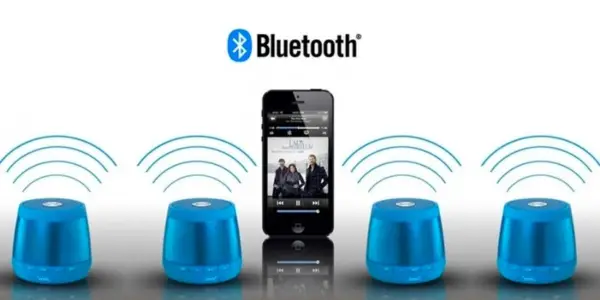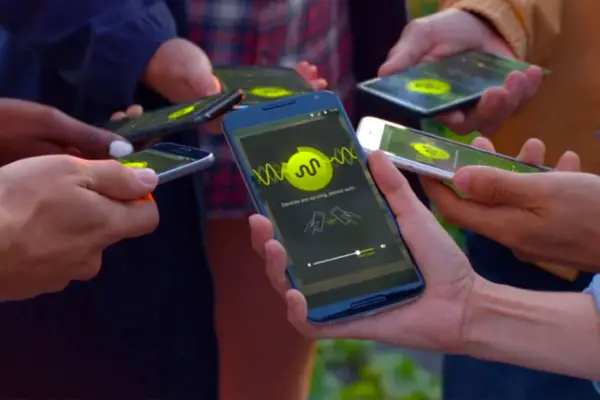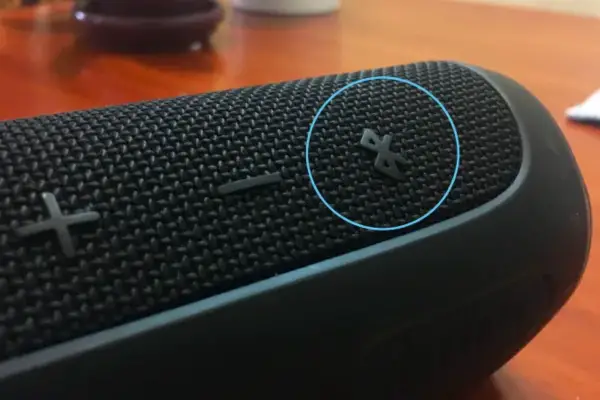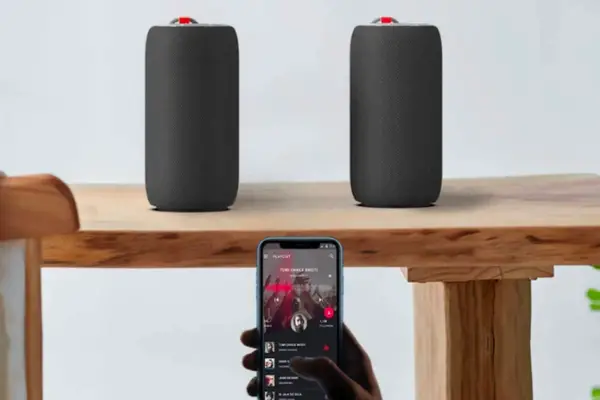How to Connect Multiple Bluetooth Speakers
Ever found yourself fumbling with tangled earphone cords or lamented the loss of that ever-so-tiny aux cable? As we embrace the world of Bluetooth and explore how to connect multiple Bluetooth speakers, it’s clear this technology has been nothing short of revolutionary, particularly when it comes to how we experience sound.
Now you can say goodbye to cables and restrictions, and welcome a soundscape where seamless integration and immersive audio reign supreme.
Bluetooth, in its simplest form, is a wireless technology that allows devices to communicate without those cumbersome cables. It’s like the magic behind our favorite earpieces, headphones, and of course, speakers!
Over the years, Bluetooth has transformed from a luxury to an everyday essential, and with that transformation, we’ve witnessed a steady rise of a particular favorite: Bluetooth speakers.
Bluetooth speakers, apart from letting us groove to our favorite tunes without the fuss of wires, come with an array of benefits. Portability, compatibility with a multitude of devices, and increasingly impressive sound quality are just the tip of the iceberg.
Now, here’s where it gets even more fascinating. Imagine not one, but multiple Bluetooth speakers belting out your favorite tunes in harmony. By connecting multiple Bluetooth speakers, you don’t just get ‘more sound’ – you get an experience, a symphony of synchronized beats that breathe life into your music, movies, or games.
Stay with me, as we dive deeper into how to connect multiple Bluetooth speakers. And by the end of the article, you’ll be keen on creating your very own orchestra of sound!
Reasons for Connecting Multiple Speakers
In the golden era of technology, it’s not just about having the latest gadgets, it’s about optimizing them for the ultimate experience. And when we talk about Bluetooth speakers, doubling or tripling up can be a game-changer.
So, why exactly would one want to connect multiple speakers together? Let’s dive into the top reasons.

Enhanced Audio Experience in Larger Spaces
Ever tried filling a spacious room or an outdoor area with just one Bluetooth speaker? While these devices can be powerful, they often have their limits.
By connecting multiple speakers, you ensure that sound waves reach every nook and cranny, giving everyone the same rich auditory experience, regardless of where they’re seated or standing. No more clustering around a single speaker at gatherings!
The Magic of Surround Sound
While single speakers can belt out impressive beats, they typically direct sound in one direction. By strategically placing and connecting multiple speakers, you can replicate a home theater’s surround sound effect. This not only enriches music playback but also brings movies and games to life by creating a multi-dimensional sound environment.
Party-Ready Anytime, Anywhere
Be it a backyard barbecue, a beach bonfire, or just a casual get-together, music is often the life of the party. With multiple speakers in play, you can elevate any event. The sound becomes more immersive, ensuring that whether someone’s by the grill, on the dance floor, or just lounging about, everyone benefits from the rhythm and vibes.
Pre-Requisites for Connection
Before we jump into the how-tos of connecting multiple Bluetooth speakers, it’s crucial to lay the foundation. Now let’s take a look at the necessary building blocks to make sure you can do it with yours…
Compatible Bluetooth Speakers
Not all Bluetooth speakers are made equal. While the core technology might be similar, different brands and models might come with varying connection capabilities.
It’s essential to ensure that the speakers you plan to connect are indeed compatible with multi-device pairing. Some brands have their ecosystem, allowing for easier pairing among their own product line, while others might be more versatile. Either way, compatibility is key.
A Device with Bluetooth Capability
Think of this as the maestro of your audio orchestra. This device acts as the primary source of sound, whether it’s music, a movie, or a podcast. Commonly used devices include smartphones, tablets, or laptops.
It’s imperative that your device not only has Bluetooth functionality but is also compatible with the version or standard your speakers support. And yes, unless it’s a pretty old device, or cheap, yours should have Bluetooth compatibility.

Methods to Connect Multiple Bluetooth Speakers
While the thought of creating a dynamic soundscape with multiple Bluetooth speakers sounds thrilling, the big question is: how does one connect multiple Bluetooth speakers?
Luckily, technology has evolved leaps and bounds, making this a relatively straightforward endeavor. Let’s delve into the predominant method.
Built-In Features
Daisy Chain Capabilities:
For those unfamiliar with the term, ‘daisy chain’ might sound like a quirky design pattern rather than a tech feature. In the world of audio, however, it refers to the ability to link multiple devices in a series.
In the context of Bluetooth speakers, daisy chaining allows one speaker to connect directly to the audio source (like your smartphone), while the other speakers connect in a sequence, one after the other. This forms an uninterrupted chain of sound.
Doing this, you might lose quality of signal further down the line, it really depends on the quality of your device.
Speakers with Out-Of-The-Box Multi-Unit Connection:
Some modern Bluetooth speakers are designed with multi-connectivity in mind. These nifty gadgets come with built-in features that let them connect to multiple units straight out of the box, without the need for additional apps or gadgets. With a few clicks, you can synchronize two, three, or even more speakers, depending on the model and its capabilities.
Brands and Models Leading the Way:
Several industry giants have recognized the allure of multi-speaker setups. Brands like JBL, with its ‘Connect+’ feature, and Ultimate Ears, boasting its ‘PartyUp’ mode, have made multi-speaker connectivity a breeze.
These are just a couple of examples, and as the demand grows, more brands are hopping on the bandwagon, each bringing their unique spin to the table. Ultimately all making it easier to connect multiple Bluetooth speakers to a device.
Using Apps
Harnessing the Power of Applications:
While built-in features have their charm, we live in an age where there’s virtually an app for everything, and synchronizing Bluetooth speakers is no exception. Enter the world of ingenious apps like AmpMe, SoundSeeder, and a few others, each designed explicitly for creating synchronized sound across multiple devices.

A Closer Look at the Apps:
- AmpMe:
A true pioneer, AmpMe lets users sync their Bluetooth speakers, regardless of the brand, to play the same audio content. Not just limited to speakers, AmpMe also enables synchronization with smartphones and tablets, turning them into makeshift speaker systems. - SoundSeeder:
Much like AmpMe, SoundSeeder offers seamless speaker syncing capabilities. But what sets it apart is its versatility. Apart from just Bluetooth speakers, it can synchronize music playback across Wi-Fi devices, creating a more extensive network of synchronized sound.
Step-by-Step Guide to Connect Multiple Speakers Using Apps
- Download & Install:
Begin by downloading your preferred app, be it AmpMe, SoundSeeder, or another similar application, from the App Store (for iOS devices) or Google Play Store (for Android devices). - Open the App & Sign Up:
Launch the application and sign up using your preferred method. Some apps might allow instant access, while others might require a brief registration process. - Connect to Your Primary Speaker:
Ensure your smartphone or tablet’s Bluetooth is turned on. Within the app, look for an option to connect to a device or speaker. Choose your primary speaker from the list of available devices. - Invite or Connect Additional Speakers:
Depending on the app, you can either invite friends to join the ‘party’ (they’ll play the same music from their device, essentially turning their device into an additional speaker) or directly connect more Bluetooth speakers. - Select Your Music and Play:
Once all devices or speakers are connected, choose the music you’d like to play. The app will then stream the audio content, ensuring synchronized playback across all devices and speakers. - Control Playback:
Most apps offer playback controls, allowing you to play, pause, skip tracks, or adjust volume across all devices seamlessly.
Bluetooth Hub or Transmitter
Understanding the Bluetooth Hub:
Often when we think of hubs, we imagine a central unit that connects various devices. In the realm of Bluetooth, a hub (or transmitter) serves a similar function. A Bluetooth hub is a device that can transmit Bluetooth signals to multiple devices simultaneously.
Unlike standard Bluetooth transmitters that typically pair with one device at a time, a hub allows for multi-device connectivity, ensuring synchronized sound across multiple speakers.
Steps to Set Up and Use a Bluetooth Hub to Connect Multiple Speakers
- Choose the Right Bluetooth Hub:
Begin by ensuring that you have a Bluetooth hub or transmitter that supports multi-device connectivity. Various models are available in the market, each with its unique set of features and capabilities. - Power Up & Get Ready:
Connect your Bluetooth hub to a power source if required. Some might run on batteries, while others could need a direct power connection. - Connect the Audio Source:
Link the audio source (this could be your smartphone, tablet, laptop, or any other device) to the Bluetooth hub. This can be achieved either through a wired connection (like an aux cable) or wirelessly if the hub supports direct Bluetooth pairing. - Activate Pairing Mode on the Hub:
Initiate the pairing mode on the Bluetooth hub. You typically do this by pressing a specific button or a combination of buttons. Refer to the hub’s user manual for specific instructions. - Pair Your Speakers:
Turn on your Bluetooth speakers and set them to pairing mode. As each speaker gets detected by the hub, you should receive a confirmation, either through an LED indicator on the hub or an auditory signal from the speaker. - Ensure Synchronized Playback:
Once all speakers are paired, play a test track from your audio source. The Bluetooth hub will transmit the audio signal to all paired speakers simultaneously, ensuring a synchronized sound experience. - Adjust and Enjoy:
Depending on your hub’s capabilities, you might be able to adjust individual speaker volumes or other settings. Experiment with speaker placements and settings to get the best audio experience.

Potential Issues and Troubleshooting
No matter how advanced technology gets, there’s always the occasional hiccup. When it comes to creating a harmonious connection between multiple Bluetooth speakers, a few challenges might arise. But fret not! With a bit of troubleshooting, you can keep the beats going.
Latency Issues
Understanding Latency:
Latency, in the world of audio, refers to the delay between an audio signal being sent and when you can hear it. When connecting multiple Bluetooth speakers, even a slight latency in one can lead to unsynchronized audio, causing an echo effect.
How to Minimize or Correct Latency Issues:
- Use aptX-Enabled Devices: The aptX codec, used in many modern Bluetooth devices, provides lower latency levels. Ensure both your audio source and speakers support this.
- Limit the Number of Connected Devices: While it might be tempting to connect as many speakers as possible, remember that more connections might increase the risk of latency. Stick to the minimum number of speakers you need for an optimal experience.
- Upgrade Firmware: Ensure your Bluetooth speakers and hubs (if used) are running the latest firmware. Manufacturers often release updates to enhance performance and reduce latency.
Connectivity Drops
Common Reasons for Connectivity Loss:
- Physical Barriers: Walls, furniture, or other obstacles can interfere with Bluetooth signals.
- Distance: Every Bluetooth device has a range. If a speaker is too far from the source or hub, it might lose connection.
- Interference: Other electronic devices or Wi-Fi networks can interfere with Bluetooth signals.
Tips to Maintain a Stable Connection:
- Optimal Placement: Keep the Bluetooth speakers within the recommended range and try to minimize physical barriers.
- Limit Interference: Turn off or move other electronic devices that might interfere. If using Wi-Fi, consider changing the channel to reduce interference.
- Re-pair: Sometimes, simply disconnecting and then re-pairing the speakers can re-establish a stable connection.
Mismatched Audio Quality
Understanding Sound Disparity:
Different speaker brands and models come with unique sound profiles. One might emphasize bass, while another might focus on treble clarity. When these are paired together, the audio quality might feel mismatched.
Recommendations for Balancing Audio:
- Equalization (EQ) Settings: If your audio source or app allows for it, adjust the EQ settings to balance out disparities in sound. For example, if one speaker lacks bass, boost the low frequencies.
- Speaker Placement: Sometimes, the perceived audio mismatch can be mitigated by adjusting the positioning of your speakers. Try different placements to find the most harmonious sound stage.
- Use Similar Brands/Models: While this might not always be feasible, using speakers from the same brand or series can ensure a more consistent results.

Safety and Maintenance Tips
When connecting multiple Bluetooth speakers, it demands a certain degree of responsibility. Ensuring the safety and longevity of your devices not only guarantees consistent performance but also stop you from getting hurt. Let’s dive into some essential safety and maintenance tips.
Keeping Bluetooth Devices Within Range
- Know the Limits: Each Bluetooth device, be it a speaker, a transmitter, or your source device, has a specified range, often dictated by its Bluetooth version. Keeping devices within this range ensures optimal performance and reduces strain on the devices.
- Monitor Signal Strength: Many modern devices show Bluetooth signal strength. A weakened signal indicates that you’re nearing the device’s limit and it’s time to move closer.
Avoiding Physical Obstructions
- Clear Line of Sight: While Bluetooth signals can travel through walls and furniture, they’re strongest when there’s a clear line of sight between the paired devices. This not only ensures a stable connection but can also improve audio quality.
- Refrain from Overcrowding: Piling up multiple electronic devices near your Bluetooth setup can cause interference. Give your devices some breathing room!
Updating Firmware for Improved Performance
- Stay Updated: Manufacturers frequently release firmware updates to rectify issues, enhance performance, and sometimes even add new features. Regularly checking for updates keeps your device in top shape.
- Follow Manufacturer Guidelines: Always follow the recommended procedure for updates. Interrupting a firmware update can sometimes cause device malfunctions.
Caring for and Storing Speakers Properly
- Clean Regularly: Dust and debris can impact a speaker’s performance. Use a soft, damp cloth to gently wipe your speakers, ensuring they’re turned off and unplugged.
- Avoid Extreme Conditions: Exposure to extreme temperatures or humidity can damage the internal components. Store your speakers in a cool, dry place.
- Use Protective Cases: If your speaker came with a protective case, use it! If not, consider purchasing one, especially if you frequently move or travel with your speaker.
- Handle with Care: This might sound like common sense, but it’s worth mentioning. Always handle your speakers gently. Avoid dropping them or placing heavy objects on top.
How to Connect multiple Bluetooth Speakers
As we’ve delved into the nuances of how to connect multiple Bluetooth speakers, it’s become clear that the future is only going to improve things. We can now intertwine multiple devices for a sonic sensation that truly stands out. But, as highlighted throughout this guide, the journey takes more than just hitting the power button.
Yet, with the right guidelines in hand and a touch of patience, the process is far from daunting. So, gear up to weave together an acoustic experiences that’s as rich as it is resonant. Happy listening!

I am a passionate and skilled car audio enthusiast with 15 years of experience in the industry. My journey started when I replaced my first set of factory car speakers, sparking a deep love for high-quality sound. Since then, I have worked as a representative for renowned brands like Kenwood and Alpine.
With a background in both retail and distribution, I have developed a comprehensive understanding of the car audio market. Currently a certified (MECP) installer in the Mobile Electronics industry, my expertise lies in delivering top-notch audio installations. My knowledge, coupled with my genuine passion, makes me the go-to professional for all car audio needs.


